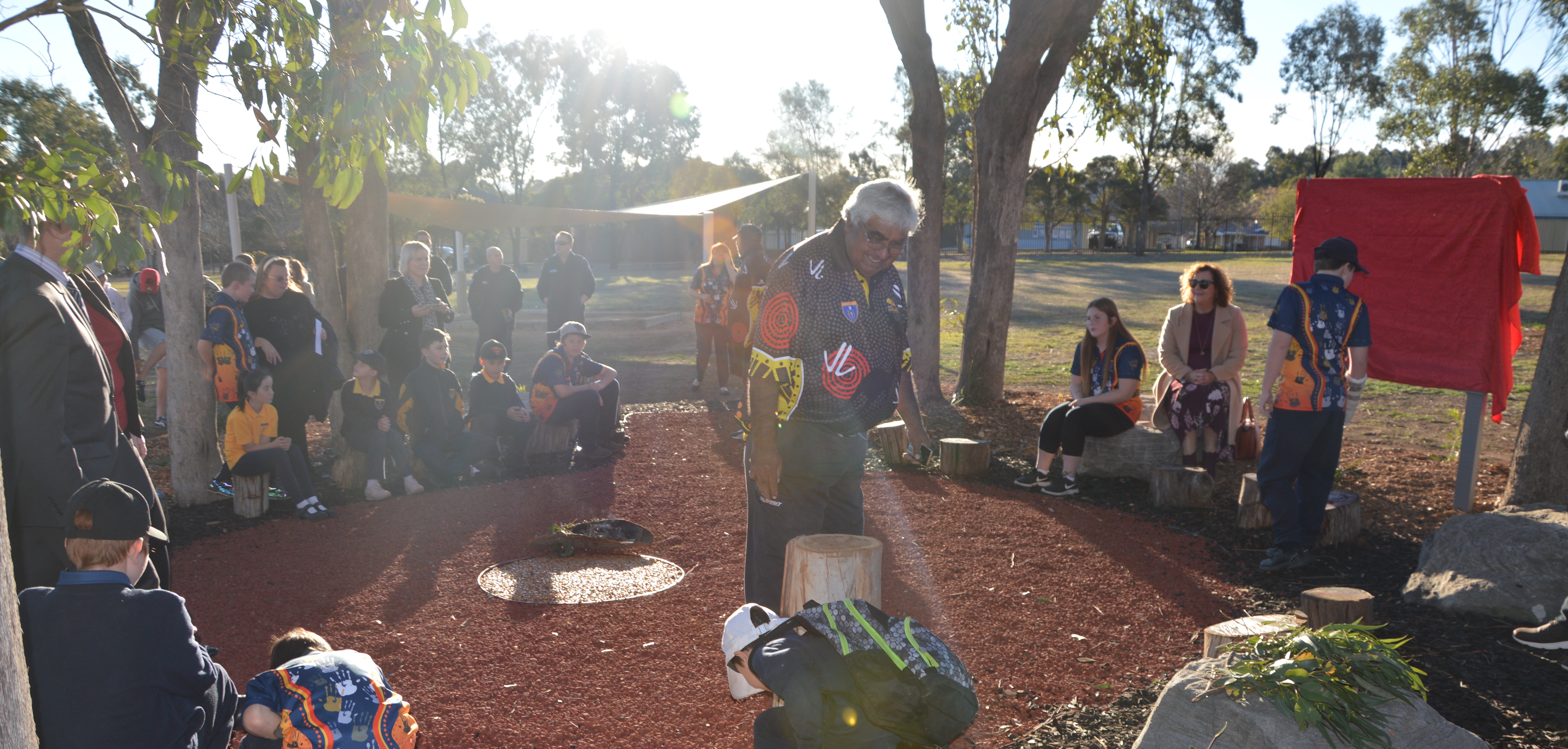Traditional Aboriginal yarning circles, where problems are discussed in a supportive group, are being increasingly adopted in the broader community to deal with mental health and wellbeing issues among young people.
In the past the circles have mostly been used to mentor Indigenous boys and young men, but a number of schools and community organisations are now using them with both Indigenous and non-Indigenous boys and girls.
Staff at Currans Hill Public School in Sydney’s south-west see it as a practical way to address real issues in a culturally aware way but with broader applications.
Last week they held an official launch of their yarning circle and bush tucker garden with staff, students, parents, carers, special guests and community members in attendance.
The community project has been a collaboration between staff and Aboriginal Elders to support students to create stronger ties with their Aboriginal heritage.
Nestled among the trees, on an elevated part of the school grounds, landscaped pathways connect to the yarning circle lined with log seats and boulders for children to gather. Murals painted by a local artist and framed with the elders handprints draw inspiration from the galahs that live in the trees above.

Yarning circles are a traditional part of Aboriginal and Torres Strait Islander culture that have been used for centuries to learn from a collective group, build respectful relationships and to preserve and pass on cultural knowledge.
Principal Sandra Wilson said the experience of a yarning circle can give Aboriginal children a practical connection to their culture that they might not get to experience.
“The yarning circle is the culmination of several years focus on developing a better understanding and respect of Aboriginal people and appreciation of Aboriginal culture within our school community,” Ms Wilson said.
“Five years ago only 14 children out of a total school population of 600 identified as Aboriginal, now we have 54. We think it is very important as a lot of them don’t know their tribe or their mob, that they have a sense of ownership and belonging.
“A lot of our children learn about Aboriginal culture in classrooms and it’s very hard for them to understand if it’s being taught via a video, book or a story. So to have the opportunity to learn about the elders’ history, has real meaning to the children as they are learning about the culture from someone they know. What’s really important to us is that this space is not just for our Aboriginal children but for all our children.”

The yarning circle was sponsored by Bunnings Gregory Hill and built by members of the Dharawal Men’s Aboriginal Corporation who attended the opening ceremony wearing shirts that the students had gifted to them.
Aboriginal Elder Uncle Ivan Wellington performed a traditional smoking ceremony and welcome to country to open the yarning circle.
Uncle Ivan, who received the University of Western Sydney Community Award in 2012, said yarning circles break down barriers between Indigenous and non-Indigenous children and can connect them “together as one”.
“It is through this circle that we learn the ways of life of the Aboriginal people and their ceremonial and spiritual connection to land and country. It provides an education for all that use it and it is where we share stories of Dreamtime,” he said.
“The kids from knowing and learning our culture will benefit and grow. They will develop a sense of themselves, a sense of belonging and a sense of their culture. I can’t think of a better way to learn and I look forward to it being used for many years to come.”

The Dharawal Men’s Aboriginal Corporation (DMAC), founded in 2009, utilises yarning circles regularly to support the male community and initiate healing.
DMAC Secretary Larry Hill said due to of the gap in Aboriginal teachings yarning circles offer Aboriginal men a connection to their culture and supports their mental health.
“A yarning circle is a scared space, it’s a learning place, it’s also a place where you can’t be discriminated in, everybody has their say and the beauty of it is that nobody is wrong, it’s a place where we get the input of everybody’s opinion,” Mr Hill said.
“We meet regularly at the bush camp for yarning circles and encourage each other to get medical checks,” he added.
“Here in Campbelltown we are so lucky to have Campbelltown Council on board, they’re incredible. I’ve spoken to people from other communities and they are blown away by the things we are doing here. There is a flow-on effect in the community when a council is Aboriginal-aware, it flows on to the community and schools.”
Currans Hill Public School is part of a Junior Aboriginal Education Consultative Group (AEGC) and works with other local schools to provide opportunities for Aboriginal students to connect with their community in the Macarthur region. Macarthur Aboriginal Kids (MAK) Day sees 200 Aboriginal students from 15 local schools onsite at Mt Annan Gardens for a full day of cultural activities.
In 2017, the school received the Nanga Mai Award for outstanding Aboriginal Education programs.
FOLLOW ON TWITTER @charliejbullis


